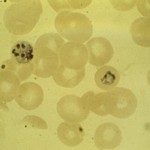Lien vers Pubmed [PMID] – 11090542
Circ Res 2000 Nov; 87(11): 984-91
During heart development, 2 fast-conducting regions of working myocardium balloon out from the slow-conducting primary myocardium of the tubular heart. Three regions of primary myocardium persist: the outflow tract, atrioventricular canal, and inflow tract, which are contiguous throughout the inner curvature of the heart. The contribution of the inflow tract to the definitive atrial chambers has remained enigmatic largely because of the lack of molecular markers that permit unambiguous identification of this myocardial domain. We now report that the genes encoding atrial natriuretic factor, myosin light chain (MLC) 3F, MLC2V, and Pitx-2, and transgenic mouse lines expressing nlacZ under the control of regulatory sequences of the mouse MLC1F/3F gene, display regionalized patterns of expression in the atrial component of the developing mouse heart. These data distinguish 4 broad transcriptional domains in the atrial myocardium: (1) the atrioventricular canal that will form the smooth-walled lower atrial rim proximal to the ventricles; (2) the atrial appendages; (3) the caval vein myocardium (systemic inlet); and (4) the mediastinal myocardium (pulmonary inlet), including the atrial septa. The pattern of expression of Pitx-2 reveals that each of these transcriptional domains has a distinct left and right component. This study reveals for the first time differential gene expression in the systemic and pulmonary inlets, which is not shared by the contiguous atrial appendages and provides evidence for multiple molecular compartments within the atrial chambers. Furthermore, this work will allow the contribution of each of these myocardial components to be studied in congenitally malformed hearts, such as those with abnormal venous return.


